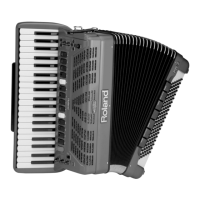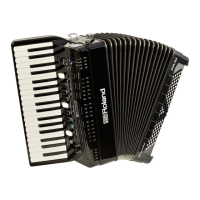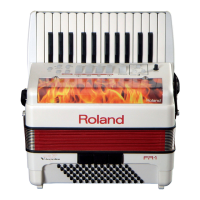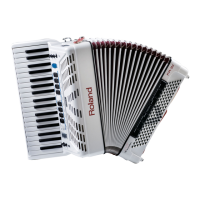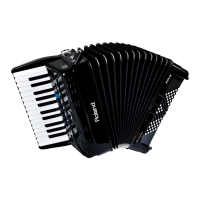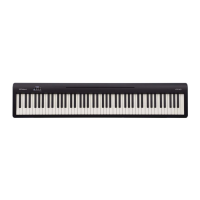Selecting Parameters
83
at your preset.
7.2 Organ Parameters
This page allows you to make additional detailed
settings for the Organ section.
Percussion
The “Percussion” parameter allows you to add a “thumping” sound
to the notes you play, making the organ more aggressive. You
can also specify the pitch, the level and the speed (onset) of the
percussion sound.
Parameter Value Explanation
Perc. Swtich O, On You can enable the Percussion sound.
Perc. Foot 2’-2/3’, 4’
• “2’-2/3”: The Percussion use the
2-2/3’ harmonic bar.
• “4’”: The Percussion use the 4’
harmonic bar.
Perc. Type Hard, Soft
Sets the percussion sound’s level.
• “Hard”: normal level
• “Soft”: softer level.
Perc. Attack Fast, Slow
Species the desired attack (aggressive-
ness) of the percussion sound.
• “Fast”: fast and more abrupt
• “Slow”: slow and longer.
Vibrato/Chorus
The vibrato eect cyclically modulates the pitch of organ sounds
(which is dierent from the Rotary eect).
The chorus eect mixes the normal sound of the organ with a
sound to which vibrato has been applied, adding richness and
spaciousness to the sound. Only one of these two eects can be
used at a time (either vibrato or chorus).
NOTE
The Vibrato/Chorus organ eects described below apply to
all Organ parts. There is one processor each for each eect.
Therefore, the left hand Organ Chord and Organ Bass parts will
use the same settings as the right hand organ part. If the right
hand organ part is not used (i.e. if the treble keyboard plays an
accordion or orchestral sound), the eects settings of the left
hand organ chord part are used and also applied to the left
hand organ bass part. (And if only the left hand organ bass part
is active, it will use its own eects settings.)
Parameter Value Explanation
Vib/Cho Switch O, On
You can apply vibrato or chorus to the
organ sound.
Vib/Cho Type
V-1, V-2, V-3
C-1, C-2, C-3
The eect will intensify as the vibrato
type (V-1, V-2, V-3) or chorus type (C-1,
C-2, C-3) moves to a higher number
Vib/Cho Vintage ‘50, ‘60, ‘70
Tonewheel used in tonewheel organs of
1950, 1960, 1970.
Vib/Cho Level 0~127
Use this parameter to set the Vibrato or
chorus level.
Overdrive
This eect distorts the sound, giving it an “edge” and making it
suitable for hard rock and similar musical genres. See also the
“NOTE” under “Vibrato/Chorus”.
Parameter Value Explanation
Overdrive Switch O, On
Allows you to switch the overdrive eect
on or o.
Overdrive Drive 0~127
Species how strongly the sound is
distorted. A value toward 127 raise the
gain, adding distortion to the sound.
Overdrive Level 0~127
Species the level of the eect with
respect to the unprocessed organ signal.
Rotary
The eect in this section simulates the typical sound modulation
generated by a cabinet with rotating loudspeakers.
Most functions (start/stop, rotation speed selection, etc.), need to
be selected with an optional MIDI foot controller (e.g. FC-300) ( p.
107), Chin Switches ( p. 98) or Function Switches ( p. 106).
Parameter Value Explanation
Leakage Level 0~127
Species the level of the eect with
respect to the unprocessed organ signal.
Rotary Snd Level 0~127 You can adjust the level of rotary eect.
Rotary Snd
Reverb
0~127
Allows yo to specify the level of the
rotary signal that is transmitted to the
reverb eect.
Choose “0” if the sound should not be
processed by the organ reverb processor.
Rotary Snd
Chorus
0~127
Allows yo to specify the level of the
rotary signal that is transmitted to the
organ chorus eect.
Choose “0” if the sound should not
be processed by the organ chorus
processor.
Rotary Snd Delay 0~127
Allows yo to specify the level of the
rotary signal that is transmitted to the
organ delay eect. Choose “0” if the
sound should not be processed by the
organ delay processor.
Bellows Crescendo
Here is an eect that allows you to use the bellows to “move”
the virtual harmonic bars. Suppose you set only one bar to the
maximum value but want to be able to increase the level of the
other bars to add special emphasis to certain notes or chords. In
that case, set the “Crescendo” parameter to a higher value than “0”
and move the bellows more forcefully.
This function temporarily increases the level of the harmonic bars.
It has no eect if all harmonic bars are already set to the maximum
level.
Parameter Value Explanation
Bellows
Crescendo
O, 1~100
Sets the organ sound’s sensitivity
to changes in the force with which
the bellows is moved. The higher
the value, the more the bellows will
inuence the organ sound.
Bellows Thres Min
0~110
(this value cannot
be higher than
the “Bellows
Thresh Max”
value)
This parameter allows you to
specify the pressure you need
to apply to the bellows to start
triggering the “Crescendo” eect.
Set a relatively high value if you
want to change the footage levels
only for accented notes.
Bellows Thres
Max
20~120
(this value cannot
be lower than
the “Thresh Min”
value)
This parameter allows you to
specify the maximum pressure
that will set the levels of all virtual
harmonic bars to maximum level.
Choosing a value below “120”
means that the Crescendo eect is
no longer applied when you press
the bellows very forcefully.
The following illustration may make things clearer:

